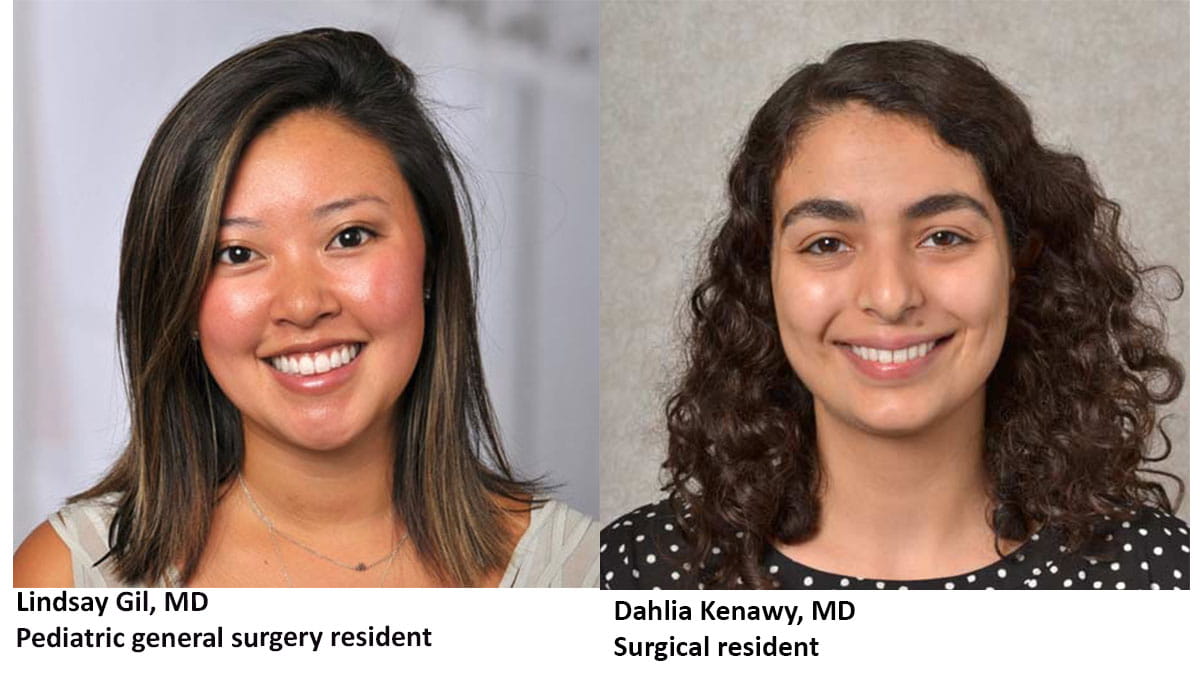Residency research takes off: Creating innovative solutions with clinical impact

Scott Holliday, MD, is a clinical associate professor of Internal Medicine and Pediatrics at the Ohio State College of Medicine. As the associate dean of Graduate Medical Education, he helps residents prepare for careers in medical research. He says at any given time many of Ohio State’s more than 1,000 resident physicians engage in research experiences with the college’s 80 accredited programs — as well as approximately 65 nonaccredited programs that are more highly specialized in nature and operate on more of an apprentice model.
“We’re able to give our residents a wide breadth of exposure and very niche education opportunities they can explore,” Dr. Holliday says. “Research in our Military Medicine Program drives a lot of interest in preserving nerve connection in major injuries.”
Lindsay Gil, MD, is a pediatric general surgery resident. She completed a pediatric surgery research fellowship through a partnership between Ohio State and Nationwide Children’s Hospital. She worked in the lab of Peter Minneci, MD, MHSC, associate professor of Surgery at the Ohio State College of Medicine, on a randomized clinical trial studying the efficacy of laser hair removal for children with pilonidal disease, a chronic skin infection that develops in the gluteal cleft. She enjoyed being part of a big trial and working with patients directly.
“We found that laser hair removal reduces rates of recurrence by 25%,” Gil says. “Dr. Minneci tasked me with writing an overview of management strategies for pilonidal disease as well as the results of the clinical trial, so I’ve now been published twice in the JAMA Surgery.”
Despite her strong research experience, Gil didn’t expect to incorporate research into her surgical career — but working in Minneci’s lab changed her mind.
“Now I definitely see myself doing research,” Gil says. “I saw how you can actually change clinical practice by doing good, well-thought-out research that makes things better for kids.”
Since her undergraduate studies at the University of Pennsylvania, surgical resident Dahlia Kenawy, MD, knew she wanted to fix things with her hands.
“I had the opportunity to take a preceptorship course where I partnered with a vascular surgeon to come up with engineering solutions for clinical problems,” Kenawy says. “It was an eye-opening experience. I loved working with my hands to help patients, and that was when I realized I wanted to be a surgeon.”
Her mentors at the Albert Einstein College of Medicine recommended Ohio State for her general surgery residency, knowing she would experience a wide variety of clinical cases in her specialty — while being adjacent to world-class engineering facilities for research into medical devices.
“Ohio State fit with what I wanted in my career,” Kenawy says.
As a surgical resident, she spent two years in the lab of vascular surgeon Bryan Tillman, MD, PhD, who is an associate professor of surgery at the Ohio State College of Medicine. He designs retrievable vascular stent grafts for multiple clinical applications. In one of these applications, the stent graft is deployed into the aorta through a catheter, allowing a surgeon to repair aortic injuries without stopping blood flow. After completing the repair, the stent can be completely removed in its entirety.
Kenawy and others in the lab helped transition the stent to being made almost completely in-house.
“The scaffolds are laser-cut by an outside company, but we were able to coat the stent in Polytetrafluoroethylene ourselves,” Kenawy explains. “That meant we were able to play with the design and have
The experience in Tillman’s lab helped shape Kenawy’s future plans, which includes an additional fellowship in minimally invasive surgery.
“I want to continue doing translational research with medical devices,” Kenawy says. “It was great to have a mentor who does exactly what I want to do — and showed me a pathway forward to incorporate this into my future career.”
Continuing with research in her surgical career also helps Kenawy make a bigger impact.
“Through medicine, you can do a lot in your community,” Kenawy says. “But through research, you can have a much wider impact. That has always really appealed to me.”
